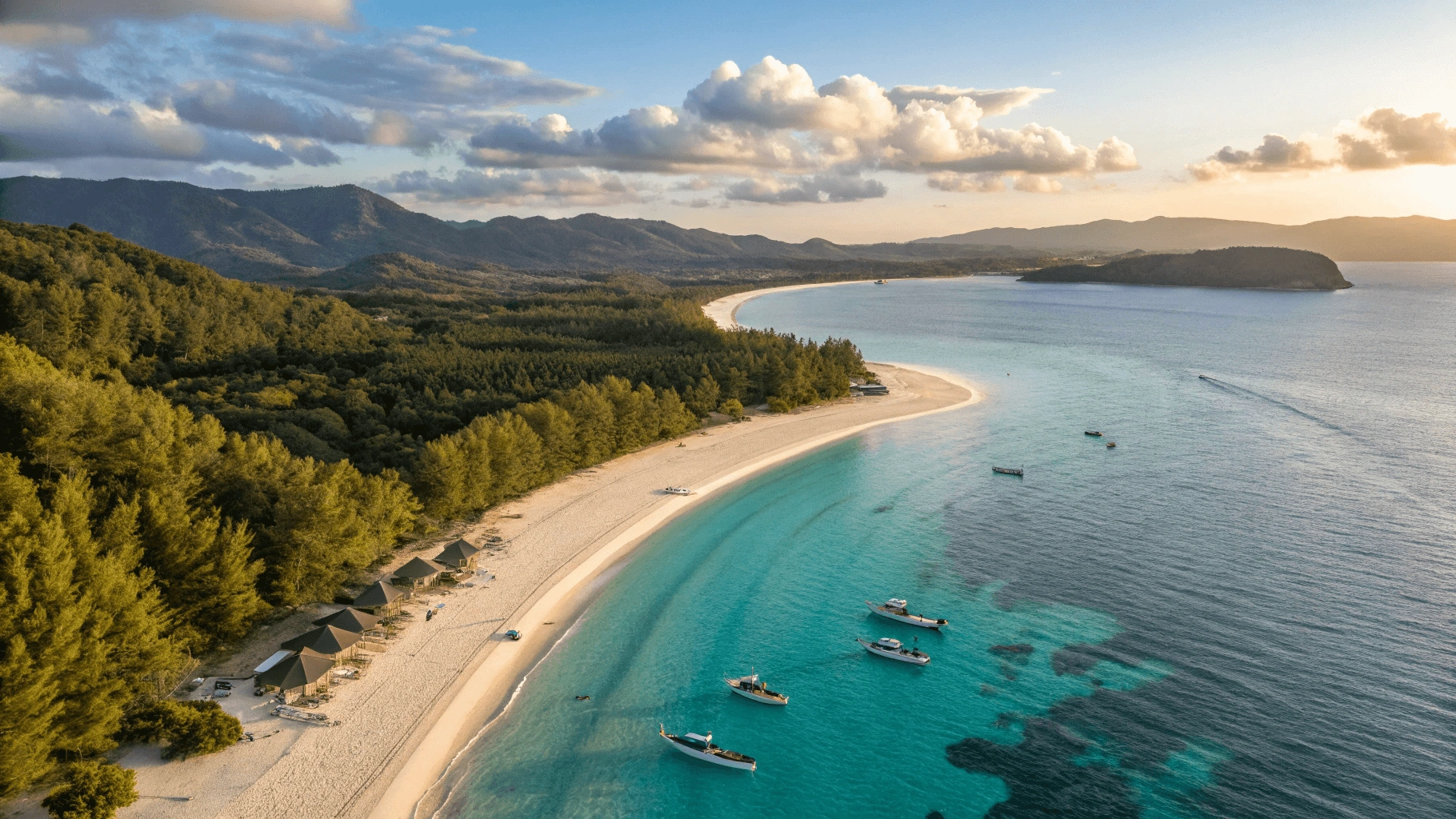When most travelers think of Japan, images of cherry blossoms, ancient temples, and neon-lit cities typically come to mind. Yet this island nation harbors a surprising secret: some of Asia’s most spectacular coastlines and beaches. From the tropical paradise of Okinawa to the dramatic shores of Hokkaido, Japan’s 18,486 miles of coastline offer beach experiences as diverse as the country’s culture itself.
This comprehensive guide covers everything you need to know about Japan’s finest beaches. Having personally visited over 50 Japanese beaches across all four main islands, I’ve compiled insights on where to find the perfect stretch of sand for every type of beach lover. Whether you’re seeking family-friendly shores with calm waters, world-class surfing spots, or secluded coves far from the tourist trail, Japan’s beaches deliver experiences that often surprise and always delight international visitors.
Table of Contents
Interactive Beach Map
Japan’s Top Beach Destinations By Region
Okinawa: Japan’s Tropical Paradise
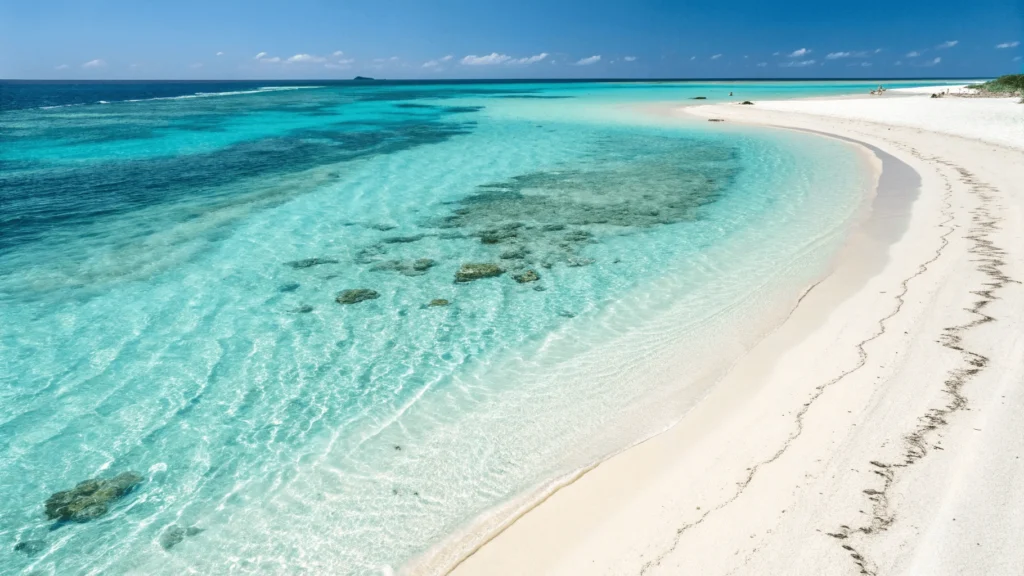
Okinawa Prefecture, comprising over 160 islands scattered across 1,000 kilometers of ocean, boasts Japan’s most famous beaches—and for good reason. Here, white sand meets crystal-clear turquoise waters in scenes that rival any Caribbean destination.
Nishihama Beach (Hateruma Island)
Overview: Often ranked among Japan’s most beautiful beaches, Nishihama stretches along the northern coast of Hateruma, Japan’s southernmost inhabited island.
Why Visit: The combination of powder-soft white sand and gradient blues of the water create a visual spectacle that feels more like a tropical paradise than Japan. The water clarity here is exceptional, even by Okinawan standards.
Best For: Photography enthusiasts, snorkelers, and those seeking tranquility away from crowds.
Key Features/Amenities:
- Pristine white sand with virtually no rocks
- Exceptional water clarity (visibility often exceeds 30 meters)
- Basic facilities including toilets and outdoor showers
- Limited rental equipment (bring your own snorkeling gear)
- Small beach huts selling refreshments during peak season
Accessibility: Requires commitment to reach. Fly to Ishigaki Island, then take a 1-hour ferry to Hateruma. The beach is a 15-minute walk or 5-minute taxi ride from the port. Limited accommodation options on the island make this best as a day trip.
Best Time to Visit: April through October, with May-June offering the ideal balance of good weather and fewer tourists.
Local Tip: Visit the southern observation point after beach time to see the “Monument of the Southernmost Point of Japan” and experience stunning stargazing opportunities (Hateruma is known for having Japan’s clearest night skies). Hateruma is officially designated as one of Japan’s best stargazing spots by the Japan National Tourism Organization (JNTO).
Pros:
- Among the clearest waters in all of Japan
- Far fewer crowds than mainland Okinawa beaches in japan
- Untouched natural beauty
Cons:
- Difficult and time-consuming to access
- Limited facilities and amenities
- Few dining options nearby
Kondoi Beach (Taketomi Island)
Overview: A perfect crescent of pristine sand with shallow, calm waters that appear to change color throughout the day.
Why Visit: Offers incredible swimming conditions in crystal-clear waters with minimal waves, making it ideal for families. The beach features picture-perfect tropical scenery without requiring long-distance travel from Ishigaki.
Best For: Families with children, casual swimmers, and those seeking easily accessible pristine beaches in japan.
Key Features/Amenities:
- Shallow, calm waters extending far from shore
- Fine white sand with minimal rocks or coral
- Well-maintained facilities (showers, changing rooms, toilets)
- Beach umbrella and chair rentals available
- Small refreshment stands during peak season
Accessibility: 10-minute ferry from Ishigaki Island, then a 20-minute walk or 5-minute bus ride from Taketomi port. Day trips are easy, but staying overnight on Taketomi allows for enjoying the beach before day-trippers arrive.
Best Time to Visit: May through October, with September offering warm waters with reduced crowds.
Local Tip: Rent a bicycle to explore the traditional Ryukyu village on Taketomi after beach time. The island’s preserved architecture and star-sand beaches make for a perfect cultural complement to your beach day.
Pros:
- Family-friendly with safe swimming conditions
- Relatively accessible compared to other remote Okinawan beaches in japan
- Beautiful scenery with Mount Omoto views in the distance
Cons:
- Can get crowded during Japanese holiday periods
- Limited shade without renting umbrellas
- Few dining options directly on the beach
Kyushu: Volcanic Shores & Hidden Gems
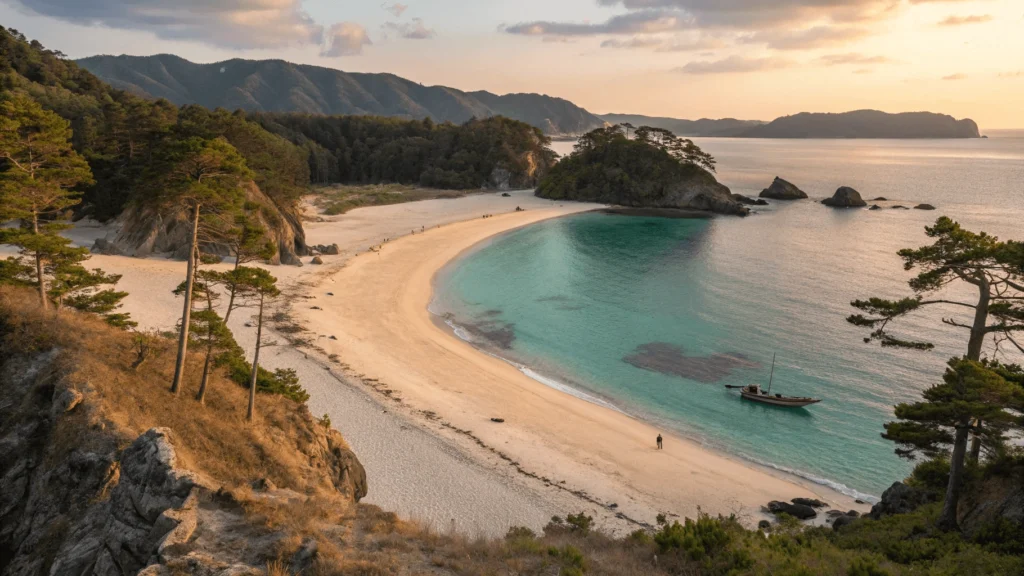
Japan’s southernmost main island features a dramatic coastline with volcanic black sand beaches, sheltered bays, and some surprisingly excellent surfing conditions.
Takahama Beach (Fukue Island, Nagasaki Prefecture)
Overview: A 1-kilometer stretch of brilliant white sand and turquoise water that frequently appears in “Japan’s best beaches” rankings.
Why Visit: This beach offers mainland-accessible tropical vibes without requiring a flight to Okinawa. The water clarity rivals many Okinawan beaches in japan, yet receives far fewer visitors.
Best For: Travelers seeking an off-the-beaten-path beach experience with stunning natural beauty.
Key Features/Amenities:
- Powdery white sand beach
- Exceptionally clear blue waters
- Basic facilities including toilets and outdoor showers
- Limited food vendors during summer season
- Camping permitted in designated areas
Accessibility: First travel to Fukuoka, then take a ferry (approximately 3 hours) or flight (40 minutes) to Fukue Island. From Fukue Port, the beach is a 40-minute drive. Rental cars are available at the port.
Best Time to Visit: July through September offers the best swimming conditions. June provides pleasant temperatures with fewer crowds.
Local Tip: Visit the nearby Onidake Observatory for breathtaking panoramic views of the island and surrounding Genkai Sea. The beach looks particularly stunning from this elevated vantage point.
Pros:
- Much less crowded than comparable beaches in Okinawa
- Natural beauty rivaling more famous Japanese beaches
- Excellent snorkeling along the rocky outcrops at each end
Cons:
- Remote location requires dedicated travel planning
- Limited accommodation options nearby
- Fewer amenities than major beach destinations
Miyazaki Nichinan Coast (Miyazaki Prefecture)
Overview: A spectacular stretch of coastline featuring dramatic rock formations, tropical vegetation, and several excellentbeaches in japan spanning over 100 kilometers.
Why Visit: This region offers diverse beach experiences—from surfing hotspots to family-friendly swimming areas—all set against a backdrop of palm trees and distinctive coastal rock formations.
Best For: Road-trippers, surfers, and photographers seeking varied coastal landscapes.
Key Features/Amenities:
- Multiple beach options along the coastal route
- Aoshima Beach: Family-friendly with facilities and shallow waters
- Kisakihama: Excellent surfing conditions with board rentals
- Devil’s Washboard: Unique geological formations along the shore
- Beach houses with food and equipment rentals during summer
Accessibility: Fly into Miyazaki Airport, then rent a car for best access to the coastal route. Public buses connect main beaches but limit flexibility.
Best Time to Visit: June through October, with September offering warm waters with reduced rainfall.
Local Tip: Plan your visit around sunset at Cape Toi, where wild horses roam freely along dramatic cliffs overlooking the ocean—a perfect end to a beach day.
Pros:
- Diverse beach experiences within close proximity
- Less crowded than many popular beach destinations
- Stunning coastal scenery beyond just the beaches themselves
Cons:
- Car rental highly recommended for full enjoyment
- Some beaches have strong currents (check local warnings)
- Outside summer season, most beach facilities close
Honshu: From Urban Escapes to Hidden Coves
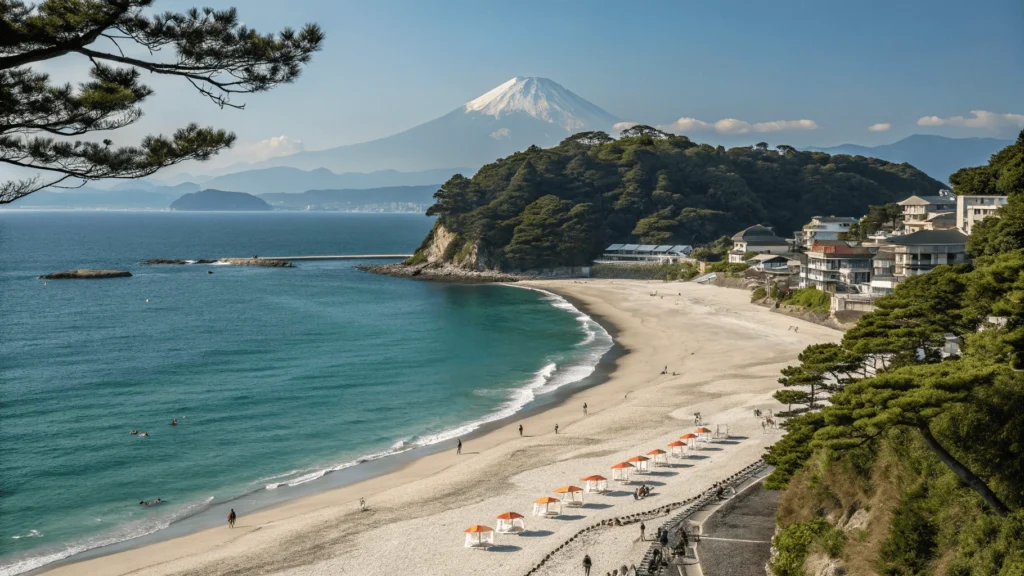
Japan’s main island offers surprising beach diversity, from easily accessible urban beaches near Tokyo to remote shorelines along the Sea of Japan.
Shirahama Beach (Shimoda, Shizuoka Prefecture)
Overview: A 800-meter crescent of striking white sand backed by pine trees, located on the Izu Peninsula just hours from Tokyo.
Why Visit: Offers tropical-quality sand and water that’s remarkably accessible as a weekend trip from Tokyo. The beach’s name literally means “white beach,” referring to its unusually fine, light-colored sand.
Best For: Tokyo residents seeking a beach escape, families, and travelers without time to reach more remote Japanese beaches.
Key Features/Amenities:
- Pristine white sand beach
- Clear blue-green waters
- Full facilities (showers, changing rooms, toilets)
- Numerous restaurants and shops along the beachfront
- Equipment rentals (parasols, chairs, bodyboards)
- Lifeguards during summer season
Accessibility: Take the JR Odoriko limited express or Tokaido Shinkansen to Ito, then transfer to the Izu Kyuko Line to Shimoda (approximately 2.5-3 hours from Tokyo). The beach is a 5-minute bus ride from Izukyu-Shimoda Station.
Best Time to Visit: July through September for swimming. Late May and June offer pleasant beach weather without peak crowds.
Local Tip: Visit Perry Road after beach time—a historic street commemorating Commodore Matthew Perry’s arrival in Japan, featuring preserved buildings and quaint cafes along a scenic canal.
Pros:
- Exceptionally accessible quality beach from Tokyo
- Complete facilities and services
- White sand quality rivals more remote beaches in japan
Cons:
- Extremely crowded during summer weekends and holidays
- Water quality, while good, doesn’t match Okinawa’s transparency
- Expensive parking if arriving by car
Jodogahama Beach (Iwate Prefecture)
Overview: A unique coastal landscape where dramatic white rock formations create a series of small, sheltered coves with crystal-clear water along Japan’s rugged Sanriku Coast.
Why Visit: Unlike typical sandy expanses, Jodogahama offers an otherworldly coastal landscape where pine-covered white rhyolite rocks create a striking contrast with the deep blue waters. The name translates to “Pure Land Beach,” referencing Buddhist paradise. The name Jodogahama is rooted in Pure Land Buddhism, which emphasizes an ideal world of beauty and peace—explained in detail by Encyclopedia Britannica.
Best For: Photographers, geology enthusiasts, and travelers seeking unique coastal scenery beyond typical beaches.
Key Features/Amenities:
- Small pebble beaches between striking white rock formations
- Exceptionally clear blue water
- Sightseeing boats available for coastal tours
- Visitor center with restaurant and information
- Walking trails along the coastline
- Public toilets and basic facilities
Accessibility: Take the Tohoku Shinkansen to Ichinoseki Station, transfer to the JR Yamada Line to Miyako Station, then take a 15-minute bus ride to Jodogahama. Alternatively, drive from Morioka (approximately 2 hours).
Best Time to Visit: June through September. Early autumn offers particularly beautiful contrasts when surrounding foliage begins changing colors.
Local Tip: Take the 45-minute Blue Cave sightseeing boat tour that departs directly from the beach area, showcasing sea caves and the coastline from a different perspective.
Pros:
- Uniquely beautiful coastal scenery unlike other Japanese beaches
- Less crowded than many beach destinations
- Combines beach experience with geological interest
Cons:
- Limited actual swimming areas
- Pebble beaches rather than sand
- Cooler water temperatures than southern Japanese beaches
Hokkaido: Wild Northern Shores
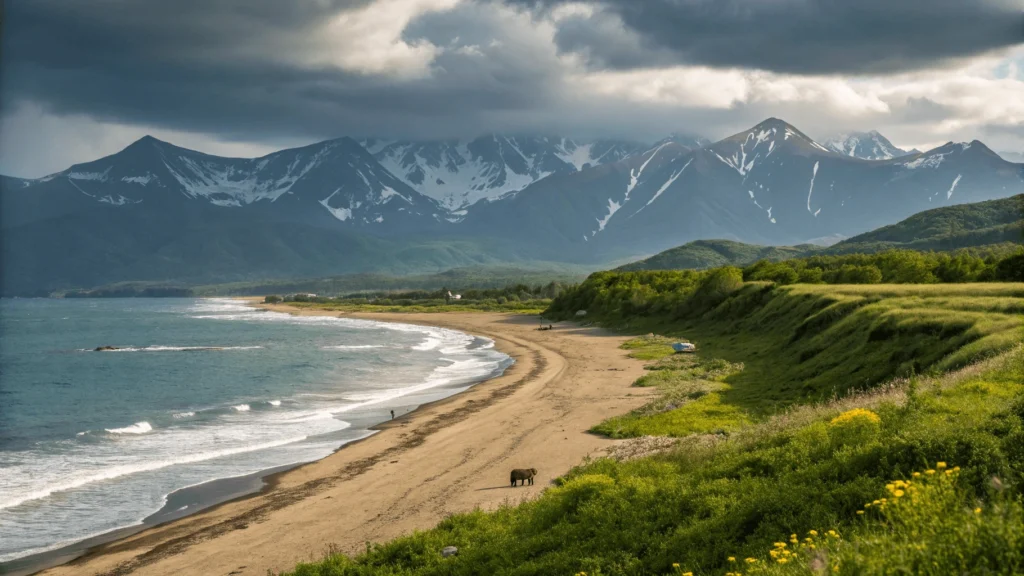
Japan’s northernmost island features rugged, pristine coastlines with dramatic scenery and surprisingly beautiful beaches—though swimming seasons are considerably shorter than southern Japan.
Shiretoko Beach (Utoro, Hokkaido)
Overview: A wild, scenic beach set against the backdrop of the UNESCO World Heritage Shiretoko Peninsula, where snow-capped mountains meet the sea. Shiretoko was designated a UNESCO World Heritage site in 2005 for its rich biodiversity and pristine ecosystems. Learn more via UNESCO.
Why Visit: Offers one of Japan’s most dramatic coastal landscapes where you can sometimes spot brown bears fishing in nearby rivers while relaxing on golden sands.
Best For: Nature lovers, photographers, and those seeking wilderness beach experiences away from crowds.
Key Features/Amenities:
- Golden sand beach with mountain views
- Crystal-clear, cold waters
- Wildlife viewing opportunities (sea eagles, occasionally bears in distance)
- Basic facilities during summer only
- Nearby hot springs for warming up after swimming
Accessibility: Fly to Memanbetsu Airport, then drive approximately 2 hours to Utoro. Alternatively, take buses from Shari or Abashiri, though service is limited.
Best Time to Visit: July and August for swimming. June and September for scenery without crowds.
Local Tip: After beach time, visit the nearby Kamuiwakka Hot Falls where naturally heated water cascades down rocks, creating natural hot spring pools (permit required, check access conditions beforehand).
Pros:
- Spectacular natural setting with mountain views
- Very uncrowded even in peak season
- Unique wildlife viewing opportunities
Cons:
- Very short swimming season (water remains cold)
- Remote location requires dedicated travel
- Limited facilities and services
Best Beaches By Type
Best Family-Friendly Beaches
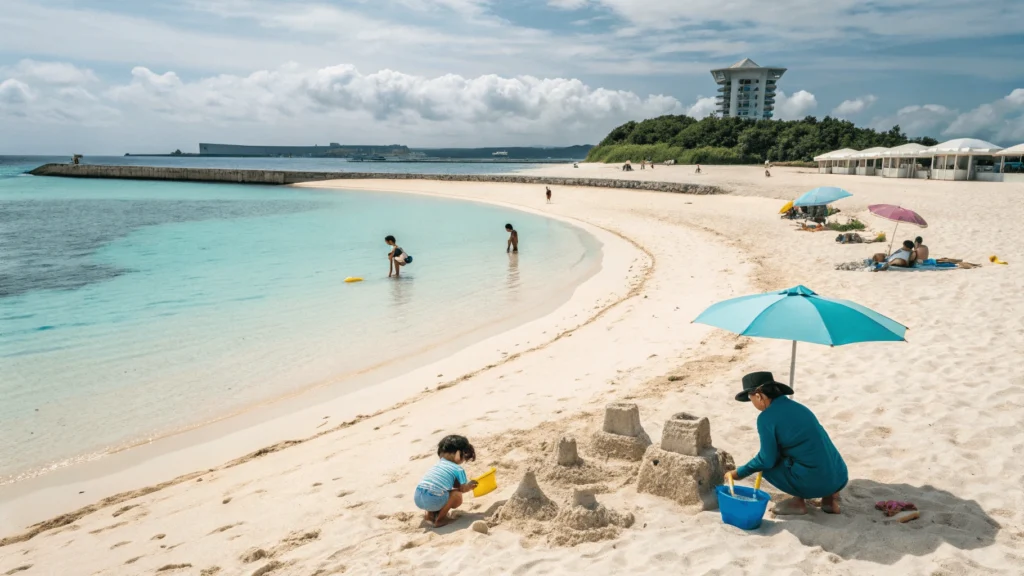
Emerald Beach (Okinawa Main Island)
Overview: Located within the Ocean Expo Park in northern Okinawa, this meticulously maintained beach offers ideal conditions for families with children.
Why Visit: Combines convenient facilities with relatively uncrowded conditions and calm, shallow waters perfect for young swimmers. The adjacent Churaumi Aquarium makes for a perfect combined day out. The Okinawa Churaumi Aquarium is one of Japan’s largest and most visited aquariums, known for its massive whale shark tank and coral reef exhibits.
Key Features/Amenities:
- Protected swimming area with gentle slope
- Fine white sand with minimal shells or rocks
- Complete facilities (showers, changing rooms, lockers)
- Lifeguards throughout opening hours
- Rental equipment (floats, umbrellas, snorkeling gear)
- Food vendors and restaurants nearby
- Adjacent to Okinawa Churaumi Aquarium
Accessibility: Located approximately 2 hours by car from Naha. Direct buses available from Naha Bus Terminal (slower but convenient). Ample parking available.
Best Time to Visit: April through October, with May and October offering pleasant conditions with fewer crowds.
Local Tip: Purchase a combined ticket for the beach and the adjoining Churaumi Aquarium (one of Japan’s best) for a full day of marine-themed activities.
Pros:
- Extremely safe swimming conditions with lifeguard supervision
- Clean facilities with family amenities (including baby changing)
- Combined attraction options for when kids tire of swimming
Cons:
- Less natural feeling than wilder beaches
- Strict opening hours (typically 8:30 AM to 5:30 PM)
- Prohibited from bringing own food to beach area
Best Surfing Beaches

Kujukuri Beach (Chiba Prefecture)
Overview: A remarkable 66-kilometer stretch of uninterrupted sandy shoreline offering consistent wave conditions just 90 minutes from Tokyo.
Why Visit: Provides Japan’s most accessible quality surfing for Tokyo residents, with consistent waves suitable for all experience levels and plenty of space to spread out even during peak times.
Key Features/Amenities:
- Consistent beach breaks suitable for beginners to intermediate surfers
- Numerous surf shops offering lessons and equipment rental
- Several surf schools with English-speaking instructors
- Beachside facilities varying by specific area
- Camping options in designated areas
- Various accommodation options from surf hostels to ryokans
Accessibility: Take the JR Sobu Line to Chiba, then transfer to the JR Togane Line or Sotobo Line depending on which section you’re visiting. Popular access points include Kujukuri, Ichinomiya, and Torami stations. Driving takes approximately 90 minutes from central Tokyo.
Best Time to Visit: Year-round surfing with different conditions. September-November offers the best combination of water temperature and wave quality.
Local Tip: The annual Chiba Open surfing tournament (usually held in May at Ichinomiya section) brings world-class surfers to the area and is worth watching even for non-surfers.
Pros:
- Waves suitable for all experience levels
- Easily accessible from Tokyo
- Extensive beach allows for finding uncrowded spots
Cons:
- Water quality can be affected after heavy rain
- Winds can sometimes create choppy conditions
- Basic facilities only in most sections
Best Snorkeling/Diving Beaches
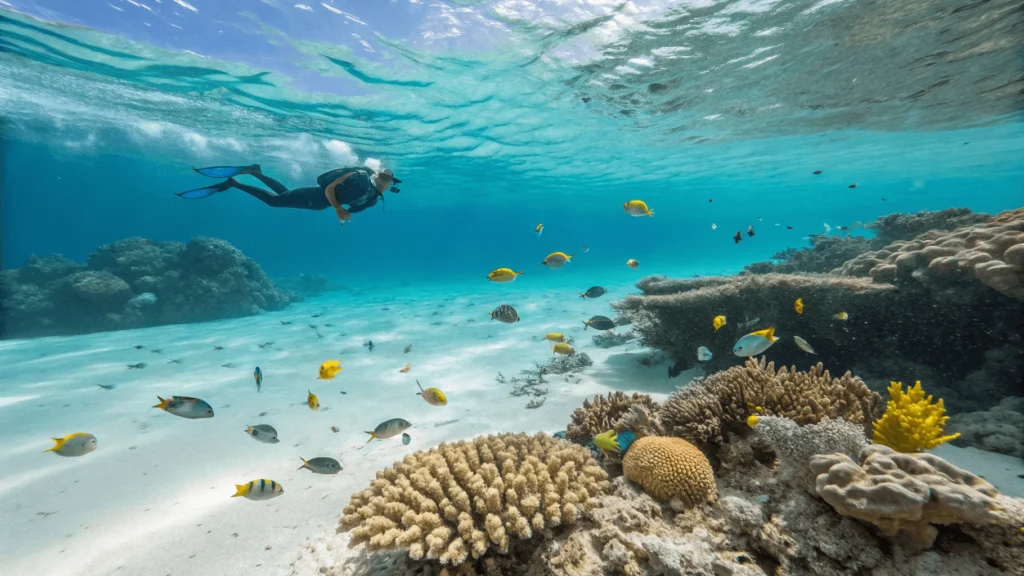
Kabira Bay (Ishigaki Island, Okinawa)
Overview: While swimming is prohibited in the bay itself (to protect its pristine ecosystem), the surrounding beaches and designated snorkeling areas offer some of Japan’s most spectacular underwater experiences.
Why Visit: The transparency of the water and diversity of marine life create a natural aquarium effect, with excellent visibility and abundant tropical fish even in shallow areas accessible to beginners.
Key Features/Amenities:
- Crystal-clear turquoise waters with 25+ meter visibility
- Diverse coral gardens with abundant marine life
- Glass-bottom boat tours of the bay
- Snorkeling equipment rental shops
- Several tour operators offering guided snorkeling
- Beach facilities at adjacent swimming beaches
Accessibility: Fly to Ishigaki Airport, then take a 30-minute bus or taxi to Kabira Bay. Several daily flights connect from Tokyo, Osaka, and Naha.
Best Time to Visit: June through October offers optimal water clarity, with May and November providing good conditions with fewer visitors.
Local Tip: While the main bay is off-limits for swimming, hire a local guide to take you to “Secret Beach” (Uganzaki), a short boat ride away that offers similar water clarity with permitted snorkeling.
Pros:
- World-class water clarity and marine diversity
- Accessible shallow reef areas perfect for beginners
- Spectacular scenery both above and below water
Cons:
- Main bay area prohibits actual swimming/snorkeling
- Can get crowded during peak tourist seasons
- Some coral damage from previous typhoons and tourism
Best Secluded Beaches
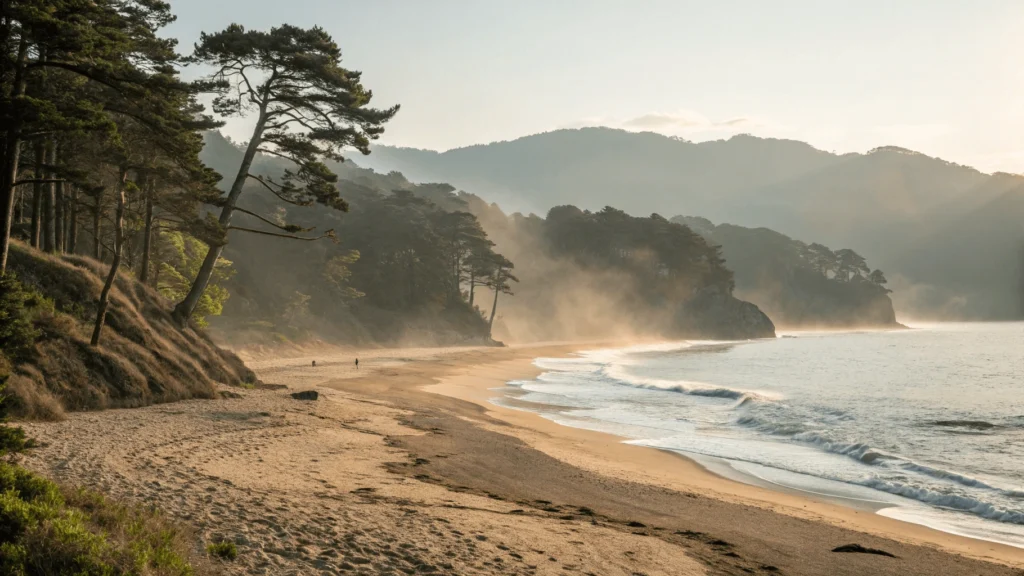
Tsutsukihama Beach (Shimane Prefecture)
Overview: A hidden gem along the Sea of Japan coast, featuring a pristine 1-kilometer crescent of soft sand backed by pine forests and minimal development.
Why Visit: Offers a sense of discovery and peaceful seclusion rarely found in more accessible Japanese beaches. Even during peak summer weekends, visitor numbers remain remarkably low.
Key Features/Amenities:
- Fine golden sand with beautiful shoreline
- Clear blue waters with gentle waves
- Minimal facilities (basic toilets only)
- Natural shade from bordering pine trees
- No commercial vendors or rentals
- Swimming permitted but no lifeguards
Accessibility: Take the JR San’in Line to Odashi Station, then taxi approximately 15 minutes to the beach. Alternatively, rent a car from Izumo or Matsue (recommended for flexibility).
Best Time to Visit: July and August for swimming. June and September offer pleasant temperatures for beach walks with virtual solitude.
Local Tip: Bring supplies for a picnic, as there are no facilities or vendors at the beach. The nearby Izumo Taisha (one of Japan’s most important Shinto shrines) makes for a perfect cultural complement to your beach day.
Pros:
- Genuine seclusion even during peak season
- Pristine natural environment
- Beautiful sunset views over the Sea of Japan
Cons:
- Very limited facilities (bring everything you need)
- Challenging to access without a car
- Limited accommodation options nearby
Best City-Accessible Beaches

Yuigahama Beach (Kamakura, Kanagawa Prefecture)
Overview: A popular 1-kilometer stretch of sandy beach located just an hour from central Tokyo in the historic city of Kamakura.
Why Visit: Offers the perfect combination of beach relaxation and cultural sightseeing, allowing visitors to enjoy morning temple visits followed by afternoon beach time.
Key Features/Amenities:
- Wide sandy beach with views of Enoshima Island
- Temporary beach houses (umi-no-ie) during summer with food/drinks
- Full rental services (parasols, chairs, bodyboards)
- Changing facilities and showers during season
- Lifeguards during official swimming season
- Mt. Fuji views on clear days
Accessibility: Take the JR Yokosuka Line from Tokyo Station to Kamakura Station (approximately 1 hour), then either walk 20 minutes or take a short bus ride to the beach.
Best Time to Visit: Official swimming season runs July-August, but May-June and September offer pleasant beach conditions without crowds.
Local Tip: Visit early morning before 9am for a peaceful experience and beautiful light for photography. Combine with a visit to the nearby Great Buddha (Daibutsu) at Kotoku-in Temple, just a 15-minute walk from the beach.
Pros:
- Exceptionally convenient access from Tokyo
- Combines well with Kamakura’s cultural attractions
- Full facilities during summer season
Cons:
- Extremely crowded on summer weekends and holidays
- Water quality suffers after rain
- Strict swimming season limitations (outside official season, entering water beyond knee-depth may result in whistle-blowing from officials)
Practical Information for Beach Visits in Japan
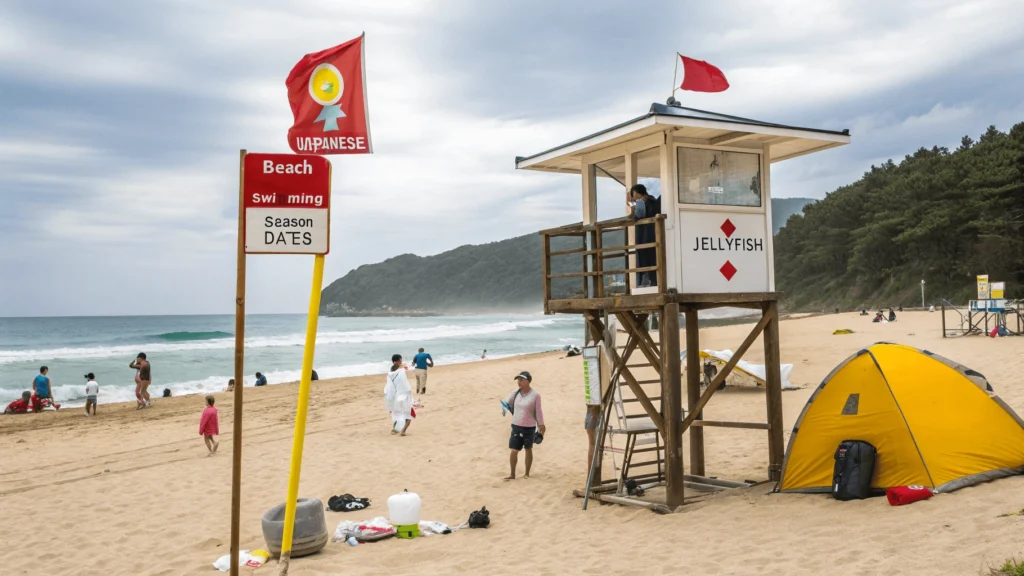
Beach Season in Japan
Japan’s beach season varies dramatically by region due to the country’s extended geography:
Okinawa:
- Swimming season: April through October
- Peak water clarity: May-June
- Warmest water: July-September
- Stinger (jellyfish) season: June-August (varies by beach)
Kyushu:
- Swimming season: June through September
- Peak conditions: July-August
- Spring/autumn suitable for beach walks and scenery
Honshu (Pacific Side):
- Official swimming season: Mid-July through August
- Extended swimming possible in southern areas (Shizuoka, Wakayama)
- Water temperature suitable for comfortable swimming: Late June to early September
Hokkaido:
- Very limited swimming season: Late July through August
- Water remains cool even in summer (typically below 20°C/68°F)
- Beach scenery enjoyable year-round
Japanese Beach Etiquette and Safety
Understanding local customs will enhance your beach experience:
Beach Etiquette:
- Most beaches have designated swimming areas marked by buoys—stay within these areas
- Changing in public is considered inappropriate—use designated changing facilities
- Tattoos remain controversial—some beaches officially prohibit them, though enforcement varies, For an overview of tattoo etiquette in Japan and where they’re accepted, see the JNTO’s tattoo-friendly guide.
- Take all trash with you—most Japanese beaches have no public garbage bins
- Loud music is generally frowned upon
- Smoking is increasingly restricted to designated areas
Safety Considerations:
- Swimming seasons are officially designated—lifeguards only present during these periods
- Flag systems indicate safe swimming conditions—red flags mean no swimming
- Jellyfish warnings are posted during risk periods
- Rip currents affect certain beaches—check local information
- Sun protection is essential—UV rays are particularly strong on Japanese beaches
- Typhoon season (August-October) can create dangerous conditions
What to Pack for Japanese Beaches
Essential Items:
- Strong sunscreen (SPF 50+ recommended)
- UV-protective clothing (rash guards popular among Japanese beachgoers)
- Beach towel or mat (beach chairs less common in Japan)
- Water shoes (for rocky or coral beaches)
- Insect repellent (especially for evening visits)
- Cash (many beach vendors don’t accept cards)
- Portable trash bag (most beaches are “pack-in, pack-out”)
- Snorkeling gear if desired (rental quality varies)
Cultural Considerations:
- Conservative swimwear is norm at public beaches
- Beach tents popular among Japanese families (rental available at major beaches)
- Waterproof case for phone/camera (photography very popular)
Understanding Jellyfish Warnings
Jellyfish (known as “kurage” in Japanese) appear seasonally at many Japanese beaches:
Common Jellyfish Types:
- Moon jellyfish (mild sting, common nationwide)
- Box jellyfish (dangerous, primarily Okinawa July-October)
- Portuguese man-o-war (dangerous, various regions during warm months)
Warning Systems:
- Purple flags typically indicate jellyfish presence
- Warning signs posted at beach entrances
- Netted swimming areas at some beaches during jellyfish season
- Vinegar stations available at many Okinawan beaches for sting treatment
Prevention/Treatment:
- Wear rash guards or wetsuits during risk periods
- Check with lifeguards about current conditions
- For stings: rinse with seawater (never freshwater) and seek medical attention for serious reactions
Conclusion
Japan’s diverse coastline offers beach experiences to satisfy every traveler, from world-class tropical paradises to unique volcanic shores and cultural coastal experiences. While Okinawa rightfully claims fame for its Caribbean-quality beaches, don’t overlook the mainland shores that offer their own distinct charm and beauty.
The best approach to enjoying Japan’s beaches is planning around regional seasons and combining beach time with Japan’s rich cultural experiences. A carefully planned beach visit can provide the perfect relaxing counterpoint to temple hopping and city exploration.
Whether you’re seeking family-friendly shores with complete facilities or remote stretches of pristine sand far from crowds, Japan’s surprising beach diversity rewards those willing to venture beyond the typical tourist trail.
Frequently Asked Questions
Can you swim in the sea in Japan?
Yes, swimming is possible along much of Japan’s coastline, though official swimming seasons vary dramatically by region. Okinawa offers the longest swimming season (April-October), while mainland beaches typically limit official swimming to July-August. Outside designated swimming seasons, entering the water beyond knee depth may be discouraged by beach officials.
Are there sharks at Japanese beaches?
While various shark species inhabit Japanese waters, shark incidents at beaches are extremely rare. Japan has recorded fewer than 10 shark attacks in the past 30 years. Most popular swimming beaches, particularly in developed areas, have never recorded shark incidents.
Which part of Japan has the best beaches?
Okinawa Prefecture undoubtedly offers Japan’s most spectacular beaches, with Yaeyama Islands (including Ishigaki, Taketomi, and Iriomote) and Kerama Islands featuring world-class white sand and crystal-clear waters. However, excellent beaches exist throughout Japan, including the Izu Peninsula (accessible from Tokyo), Shirahama (Wakayama), and the Goto Islands (Nagasaki).
When is jellyfish season in Japan?
Jellyfish seasons vary by region and species. In Okinawa, box jellyfish (habu kurage) typically appear July-October, with peak risk in August-September. On mainland beaches, various jellyfish species may appear during summer months, with moon jellyfish being most common but less dangerous. Always check local warnings and beach flags before swimming.
Are beaches in Japan sandy or rocky?
Japan features both sandy and rocky beaches, often in close proximity. The country’s volcanic geology creates diverse coastal landscapes, including white sand beaches (particularly in Okinawa), black volcanic sand (parts of Izu Peninsula), golden sand beaches (Sea of Japan coast), and dramatic rocky shorelines. Major tourist-oriented beaches typically feature sand suitable for comfortable beach activities.
About the Author
As a travel writer specializing in Asian destinations, I’ve spent over fifteen years exploring Japan’s coastlines from the tropical shores of Okinawa to the wild beaches of Hokkaido. This guide represents personal visits to over 50 Japanese beaches across all four main islands, updated with the latest information for 2025 travelers.
Last Updated: April 19, 2025

